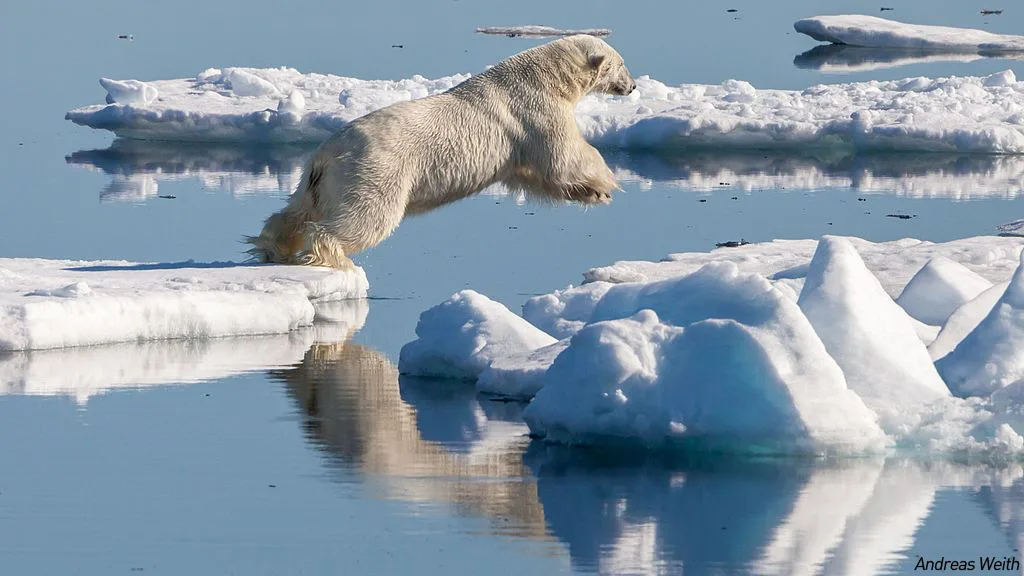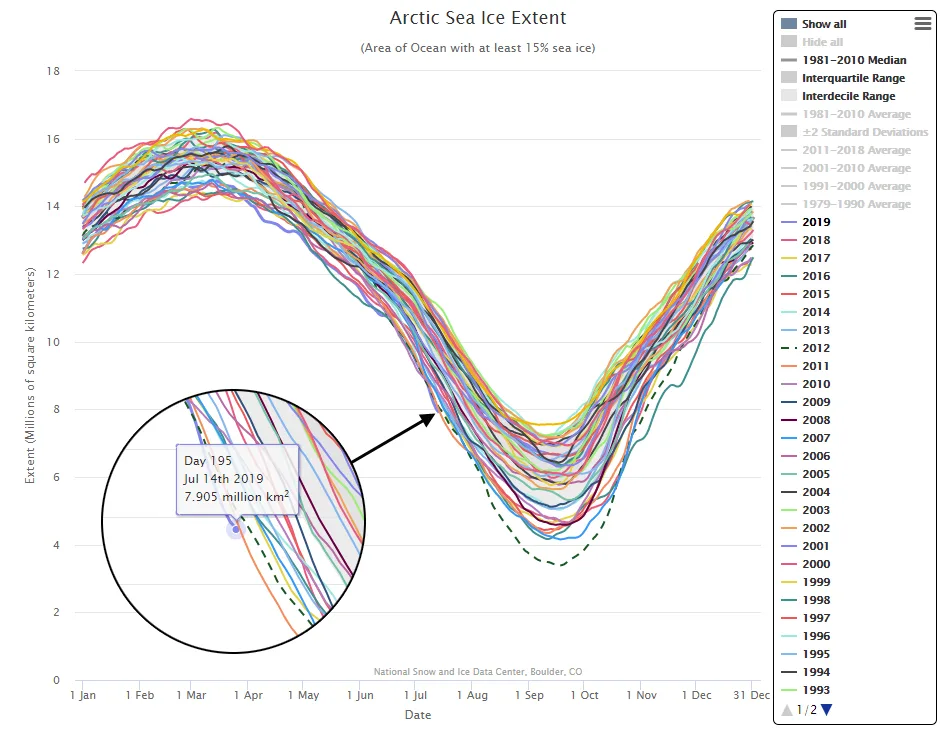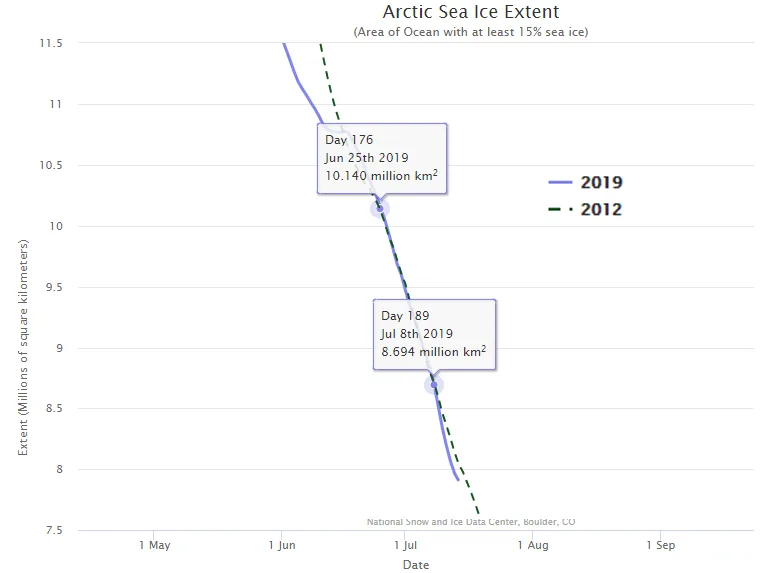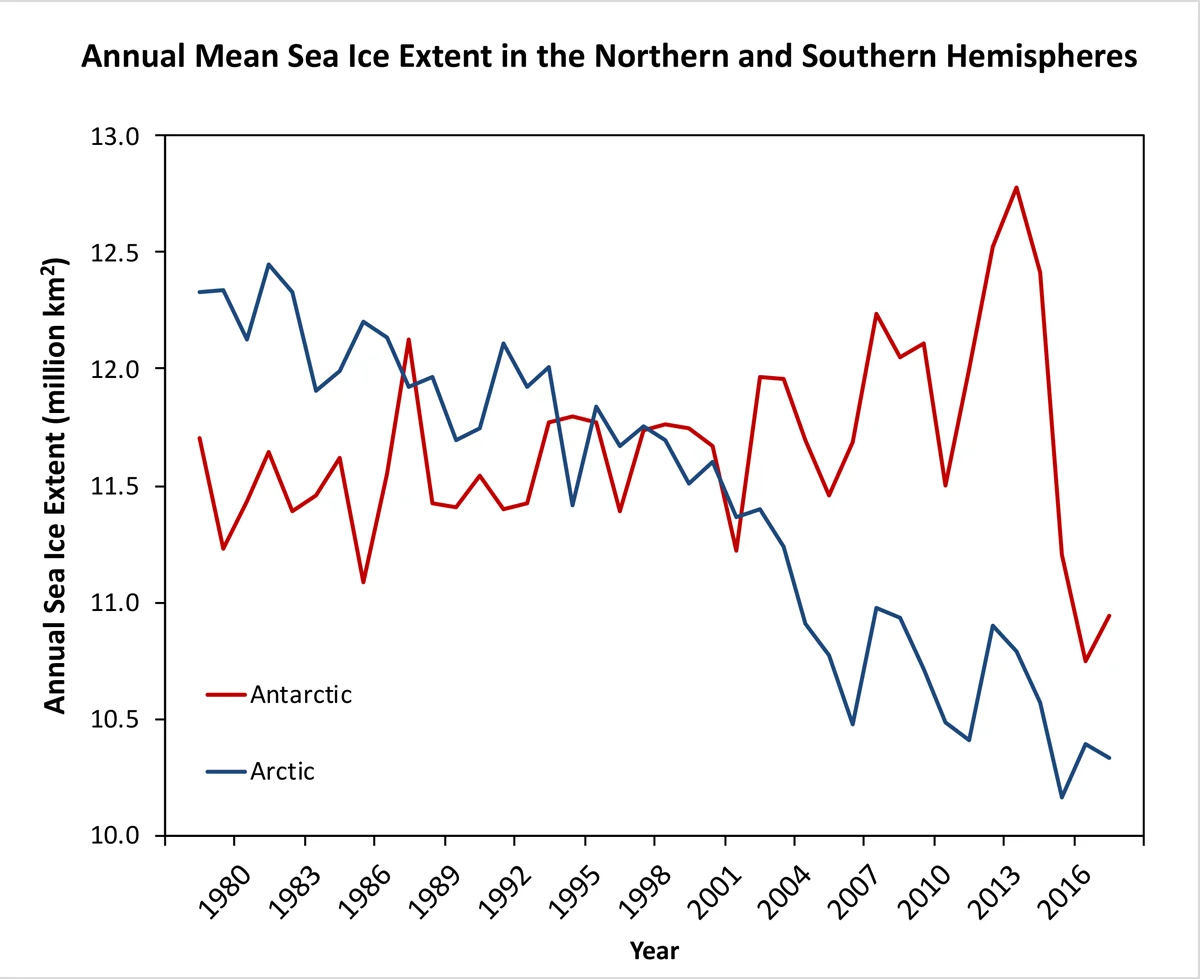
Arctic Sea Ice Day punctuated by lowest ice extent on record
July 15 is Polar Bears International's Arctic Sea Ice Day.
Arctic sea ice is a vital component of Earth's climate system and a vital resource for wildlife, such as polar bears, but it is in the midst of an unprecedented decline due to climate change.
As of July 15, Polar Bears International's Arctic Sea Ice Day, the extent of the ice in the Arctic Ocean is at its lowest level on record.

The Charctic Interactive Sea Ice Graph for July 15, 2019, shows that the Arctic Sea Ice Extent is now at a record low. 2012 currently stands out, the dashed green line, as the lowest summer minimum extent on record. For Sea Ice Extent, an area of the ocean contributes to this value if it is recorded as having at least 15 per cent ice. Credit: NSIDC/Scott Sutherland
As of July 14, 2019, the U.S. National Snow and Ice Data Center (NSIDC) recorded an Arctic sea ice extent of 7.905 million square kilometres. That is currently the lowest daily average since record-keeping began in 1979 - lower than the previous record of 7.96 million km² extent, seen in 2011, and lower than the 7.98 million square km² extent from 2012, the year we saw the lowest summer minimum extent in the record books.
2019's daily Arctic sea ice extents have already reached record low levels once this year, as they spent the entire month of April as the lowest points on the graph, due to warmer than normal temperatures across the Arctic.
Watch Below: How hot is it in the Arctic right now? Meteorologist Tyler Hamilton has the details
This is now the first year where sea ice extent values have dipped as low as in 2012 at this time of year, as 2019 daily values tracked fairly even with 2012 daily values between June 24 to July 8. It is also the first year since 2012 that daily values have dipped below that stand-out year during the summer months.

Charctic graph values only for 2012 (green dashed line) and 2019 (solid purple line), show the two closely matching from June 24 to July 8, after which the 2019 values dipped again. Credit: NSIDC/Scott Sutherland
As we have seen in previous years, even when values approached the 2012 record low, the rate of ice loss slowed enough for 2012 to remain the lowest ice extent year on record. Although ice extents leading up to 2012 had been reaching new lows every few years, thus weakening the overall ice cap, 2012's shocking low was partly due to an intense August storm.
According to a study of 'the great Arctic cyclone of August 2012': "Not only did the major August 2012 storm facilitate the melt of sea ice by bringing to the Arctic heat and moisture from the south, but by shearing off a sizeable segment of the ice (approximately 0.4 [million] km²), it further led to an accelerated ice‐cover decay."
Summer minimum extent for sea ice is an important indicator for the health of the ice cap, but even though we haven't reached a new record summer minimum in the past 6 years, the annual average for sea ice shows that we are far from being out of danger.

Annual sea ice extents for the Arctic and Antarctic, from 1979 to 2018, show the dramatic decline in yearly average extent in the Arctic. Antarctic sea ice extent shows a slightly positive trend, due to ice losses from over land (especially in West Antarctica), with a contribution of stronger winds blowing ice farther away from the continent). Credit: NSIDC
With daily values having now dipped below both the 2011 and 2012 record lows, there is the definite potential for another storm or bout of Arctic heat to make 2019 the year we set a new low for summer minimum extent.
AN EARTH AWARENESS DAY
Polar Bears International introduced Arctic Sea Ice Day as an Earth awareness day, to call attention to the loss of Arctic sea ice, and to promote ideas for how we can reverse the trend.
"We chose July 15th because the breakup on Western Hudson Bay was historically in mid-July, with considerable natural fluctuation between years," Polar Bears International wrote on their website. "Now the breakup is over three weeks earlier, on average, then it was in the 1980s."
Sea ice in the Arctic helps cool the planet by reflecting sunlight back into space. Additionally, it is a vital habitat for polar bears, as they use the ice to travel far and wide in their search for food. As the ice extent dwindles, this amounts of a loss of habitat for these animals, threatening their continued existence.
Sources: National Snow and Ice Data Center | Polar Bears International | AGU
Teaser image courtesy Andreas Weith/Wikimedia Commons.











